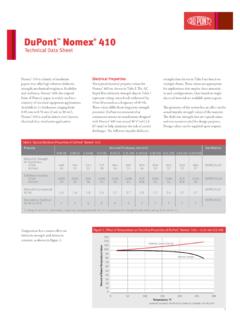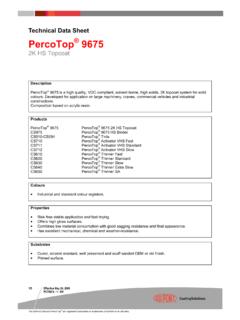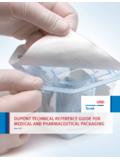Transcription of Univar USA Inc Material Safety Data Sheet
1 Univar USA Inc Material Safety data Sheet MSDS No: Version No: Order No: Univar USA Inc., 17425 NE Union Hill Rd., Redmond WA 98052 (425) 889 3400 Emergency Assistance For emergency assistance involving chemicals call Chemtrec - (800) 424-9300 022 2010-01-27DQ4950 CRPRODUCT NAME: SULFURIC ACID, 77 TO 100% DATE ISSUED: 01/07/2009 Material Safety data Sheet CHEMICAL PRODUCT/COMPANY IDENTIFICATION Material Identification CAS Number : 7664-93-9 Formula : H2SO4 Molecular Weight : CAS Name : SULFURIC ACID Grade : 77 to 100% TECHNICAL Distributed by: Univar USA Inc. 17425 NE Union Hill Road Redmond, WA 98052 425-889-3400 Chemtrec: 1-800-424-9300 PHONE NUMBERS Transport Emergency : CHEMTREC 1-800-424-9300(outside 703-527-3887) COMPOSITION/INFORMATION ON INGREDIENTS Components Material CAS Number % SULFURIC ACID 7664-93-9 STRONG ACID MISTS CONTAINING SULFURIC ACID 60 DEG TECHNICAL 66 DEG TECHNICAL ELECTROLYTE 98% TECHNICAL 98 99% TECHNICAL 99 100% TECHNICAL 100 WATER 7732-18-5 0-22 HAZARDS IDENTIFICATION Potential Health Effects Exposure to Sulfuric Acid mists by inhalation may cause irritation of the nose and throat with sneezing, sore throat or runny nose.
2 Non-specific effects such as headache, nausea and weakness. Gross overexposure may cause irritation of nose, throat, and lungs with cough, difficulty breathing or shortness of breath. Pulmonary edema (body fluid in the lungs) with cough, wheezing, abnormal lung sounds, possibly progressing to severe shortness of breath and bluish discoloration of the skin; symptoms may be delayed. Repeated and/or prolonged exposure to mists may cause corrosion of teeth. Univar USA NO:DQ4950 CRISSUE DATE:2009-01-07 VERSION:022 2010-01-27 Annotation: Skin contact with liquid Sulfuric Acid may cause skin corrosion, burns or ulcers. Contact with a 1 % solution may cause slight irritation with itching, redness or swelling. Repeated and/or prolonged exposure to mists may cause irritation with itching, burning, redness, swelling or rash. Eye contact with liquid Sulfuric Acid may cause eye corrosion or ulceration; blindness may result. Repeated and/or prolonged exposure to mists may cause eye irritation with tearing, pain or blurred vision.
3 Immediate effects of ingestion of Sulfuric Acid may include burns of the mouth, throat, esophagus and stomach, with severe pain, bleeding, vomiting, diarrhea and collapse of blood pressure - damage may appear days after exposure. Increased susceptibility to the effects of this Material may be observed in persons with pre-existing disease of the lungs. The International Agency for Research on Cancer (IARC) classified "strong inorganic acid mists containing sulfuric acid" as a Category 1 carcinogen, a substance that is "carcinogenic to humans". This classification is for strong inorganic acid mists only and does not apply to sulfuric acid or sulfuric acid solutions. The basis for the IARC classification rests on several epidemiology studies which have several deficiencies. These studies did not account for exposure to other substances, some known to be animal or potential human carcinogens, social influences (smoking, etc.) and included small numbers of subjects.
4 Based on the overall weight of evidence from all human and chronic animal studies, no definitive casual relationship between sulfuric acid mist exposure and respiratory tract tumors has been shown. Strong inorganic acid mists containing sulfuric acid are also listed by The National Toxicology Program (NTP) as known human carcinogens. This limits the classification to sulfuric acid aerosols and does not extend to the liquid product, unless the acid is used under conditions that result in the formation of mists or aerosols. Fuming acid is covered by the classification. # Carcinogenicity Information The following components are listed by IARC, NTP, OSHA or ACGIH as carcinogens. Material IARC NTP OSHA ACGIH STRONG ACID MISTS CONTAINING SULFURIC ACID 1 X A2 FIRST AID MEASURES First Aid INHALATION If inhaled, immediately remove to fresh air. If not breathing, give artificial respiration.
5 If breathing is difficult, give oxygen. Symptoms may be delayed; prompt medical attention may be required. Call a physician. Univar USA NO:DQ4950 CRISSUE DATE:2009-01-07 VERSION:022 2010-01-27 Annotation: SKIN CONTACT In case of contact, immediately flush skin with plenty of water for at least 15 minutes, while removing contaminated clothing and shoes. Call a physician. Wash contaminated clothing before reuse. While the patient is being transported to a medical facility, continue the application of cold, wet compresses. If medical treatment must be delayed, repeat the flushing with cold water or soak the affected area with cold water to help remove the last traces of sulfuric acid. Creams or ointments should not be applied before or during the washing phase of treatment. EYE CONTACT In case of contact, immediately flush eyes with plenty of water for at least 15 minutes. Call a physician. INGESTION If swallowed, do not induce vomiting. Give large quantity of water.
6 Call a physician immediately. Never give anything by mouth to an unconscious person. Notes to Physicians Continued washing of the affected area with cold or iced water will be helpful in removing the last traces of sulfuric acid. Creams or ointments should not be applied before or during the washing phase of the treatment. FIRE FIGHTING MEASURES Flammable Properties Will not burn. Fire and Explosion Hazards: Reacts with most metals, especially when dilute, to give flammable, potentially explosive hydrogen gas. Follow appropriate National Fire Protection Association (NFPA) codes. Extinguishing Media Use media appropriate for surrounding Material . Use water spray to cool containers exposed to fire; do not get water inside containers. Fire Fighting Instructions Evacuate personnel to a safe area. Keep personnel removed and upwind of fire. Generates heat upon addition of water, with possible spattering. Wear full protective clothing. Runoff from fire control may cause pollution.
7 Neutralize run-off with lime, soda ash, etc., to prevent corrosion of metals and formation of hydrogen gas. Wear self-contained breathing apparatus if fumes or mists are present. Univar USA NO:DQ4950 CRISSUE DATE:2009-01-07 VERSION:022 2010-01-27 Annotation: ACCIDENTAL RELEASE MEASURES Safeguards (Personnel) NOTE: Review FIRE FIGHTING MEASURES and HANDLING (PERSONNEL) sections before proceeding with clean-up. Use appropriate PERSONAL PROTECTIVE EQUIPMENT during clean-up. Accidental Release Measures Stop flow if possible. Review "Fire and Explosion Hazards" and " Safety Precautions" before proceeding with clean up. Use appropriate protective equipment during clean up. Soak up small spills with dry sand, clay or diatomaceous earth. Dike large spills, and cautiously dilute and neutralize with lime or soda ash, and transfer to waste water treatment system. Prevent liquid from entering sewers, waterways, or low areas. If this product is spilled and not recovered, or is recovered as a waste for treatment or disposal, the Reportable Quantity is 1,000 lbs.
8 (based on the sulfuric acid content of the solution spilled). Comply with Federal, State, and local regulations on reporting releases. DuPont Emergency Exposure Limits (EEL) are established to facilitate site or plant emergency evacuation and specify airborne concentrations of brief durations which should not result in permanent adverse health effects or interfere with escape. EEL's are expressed as airborne concentration multiplied by time (CxT) for up to a maximum of 60 minutes and as a ceiling airborne concentration. These limits are used in conjunction with engineering controls/monitoring and as an aid in planning for episodic releases and spills. The DuPont Emergency Exposure Limit (EEL) for Sulfuric Acid is 10 mg/m3 for 15 to 60 minutes and 20 mg/m3 for up to 15 minutes with a not-to-exceed ceiling of 20 mg/m3. HANDLING AND STORAGE Handling (Personnel) Do not get in eyes, on skin, or on clothing. Avoid breathing vapors or mist. Wash thoroughly after handling.
9 Keep containers closed. Do not add water to contents while in container because of violent reaction. Storage Keep out of sun and away from heat, sparks, and flame. Keep container tightly closed and (drum) closure up to prevent leakage. Loosen closure carefully. Relieve internal pressure when received and at least weekly thereafter. Do not use pressure to empty. Be sure closure is securely fastened before moving container. Do not wash out container or use it for other purposes; replace closure after each withdrawal and return it with empty container. Univar USA NO:DQ4950 CRISSUE DATE:2009-01-07 VERSION:022 2010-01-27 Annotation: EXPOSURE CONTROLS/PERSONAL PROTECTION Engineering Controls Good general ventilation should be provided to keep vapor and mist concentrations below the exposure limits. Personal Protective Equipment Have available and wear as appropriate for exposure conditions when handling containers or operating equipment containing sulfuric acid: chemical splash goggles; full-length face shield/chemical splash goggles combination; acid- proof gauntlet gloves, apron, and boots; long sleeve wool, acrylic, or polyester clothing; acid proof suit and hood; and appropriate NIOSH respiratory protection.
10 In case of emergency or where there is a strong possibility of considerable exposure, wear a complete acid suit with hood, boots, and gloves. If acid vapor or mist are present and exposure limits may be exceeded, wear appropriate NIOSH respiratory protection. Exposure Guidelines Exposure Limits Sulfuric Acid, 77 to 100% PEL (OSHA) : 1 mg/m3, 8 Hr. TWA TLV (ACGIH) : mg/m3, 8 Hr. TWA A2 (Sulfuric acid contained in strong inorganic acid mists) AEL * (DuPont) : mg/m3, 8 & 12 Hr. TWA mg/m3, 15 minute TWA * AEL is DuPont's Acceptable Exposure Limit. Where governmentally imposed occupational exposure limits which are lower than the AEL are in effect, such limits shall take precedence. PHYSICAL AND CHEMICAL PROPERTIES Physical data Boiling Point : 193-327 C (379-621 F) @ 760 mm Hg Vapor Pressure : < mm Hg @ 25 C (77 F) < mm Hg @ 38 C (100 F) Vapor Density : Melting Point : -35 to 11 C (-31 to 52 F) Evaporation Rate : <1 (Butyl Acetate= ) Solubility in Water : 100 WT% pH : <1 Odor : Odorless.








